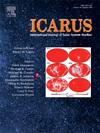兰提拉白长岩矿物学研究:发光和近红外反射光谱研究
IF 3
2区 物理与天体物理
Q2 ASTRONOMY & ASTROPHYSICS
引用次数: 0
摘要
2022年8月,印度古吉拉特邦的兰提拉坠落。本研究旨在研究该陨石的三个碎片的矿物学和矿物化学,并与可见光和近红外光谱范围(VNIR)和激光诱导时间分辨发光(LITRL)的反射光谱进行关联。极低的Fe2+含量阻止了紫外光照射下的发光猝灭,使这些陨石表现出明确的发光。所调查的样品具有不同的外观。一种由浅色部分组成,主要由不含铁的顽辉石、长辉石、透辉石、斜长石、少量硫化物(三辉石、闪辉石、灰质和(Fe、Ca、Mn、Mg)S)和钾辉石组成。第二个样品主要由相同的浅色部分组成,并含有一个深色的橄榄石碎屑。第三个样品主要是深色玻璃。观察到轻微的陆地风化,探测到零星的氧化铁/氢氧化物。检测到的相的化学组成表明在形成过程中高度还原的条件,正如预期的那样。在主要元素浓度方面,不同碎片的矿物化学性质相似;在小元素上观察到一些差异。发光光谱显示,其中两种样品的透辉石和橄榄石中分别以Cr3+和Mn2+为激活剂。第三个样品中以Ce3+为活化剂,缺少橄榄石,透辉石中Cr2O3含量低于其他两个样品。因此,发光数据进一步强调了通过电子探针分析(EPMA)观察到的矿物化学差异。研究其发光行为可以为这些材料的矿物学-岩石学研究提供有价值的贡献。近红外(VNIR)反射光谱与低FeCa辉石和森林长辉石相一致。基性矿物典型的主要吸收层(~ 0.9 μm)比以前在铝土中观察到的更深:这可能与略高的FeO浓度有关,尽管FeO浓度很低(<0.4 wt%),但仍然有助于吸收。~ 1.4 μm和~ 1.9 μm的吸收特征与低陆相风化的存在一致。增加对高度还原陨石的光谱特性和矿物学/矿物化学之间的相关性的了解,将有助于未来ESA的BepiColombo任务对水星的调查。特别是用于解释MPO贝皮可伦坡综合观测系统(SIMBIO-SYS)/可见光和近红外高光谱成像仪(VIHI)以及汞辐射计和热红外光谱仪(MERTIS)仪器的光谱仪和成像仪的数据本文章由计算机程序翻译,如有差异,请以英文原文为准。
Insights into the mineralogy of the Rantila aubrite: A luminescence and VNIR reflectance spectroscopy study
Rantila aubrite fell in Rantila, Gujarat, India, in August 2022. This study aims to investigate the mineralogy and mineral-chemistry of three fragments of this meteorite and correlate them with reflectance spectroscopy in the visible and near-infrared spectral range (VNIR) and Laser-Induced Time-Resolved Luminescence (LITRL). Aubrites very low Fe2+ content prevents luminescence quenching under UV light exposure, allowing these meteorites to exhibit well-defined luminescence. The investigated samples have different appearances. One consists of a light-coloured portion primarily composed of FeO-free enstatite, along with forsterite, diopside, plagioclase, minor sulphides (troilite, alabandite, daubréelite, and (Fe,Ca,Mn,Mg)S), and kamacite. The second sample is composed mainly of the same light-coloured portion and hosts a dark forsterite clast. The third sample is mainly made of dark glass. Minor terrestrial weathering is observed, with the detection of sporadic iron oxides/hydroxides. The chemical composition of the detected phases indicates highly reducing conditions during the formation, as expected for an aubrite. The mineral chemistry is similar among the different fragments in terms of major elements concentrations; some differences are observed for minor elements. Luminescence spectra indicate Cr3+ and Mn2+ as activators in diopside and forsterite, respectively, for two of the three samples. Ce3+ is the activator in the third sample, which lacks forsterite and has lower Cr2O3 contents in diopside compared to the other two samples. Therefore, the differences in mineral chemistry observed through electron microprobe analysis (EPMA) are further emphasized by luminescence data. Investigating the luminescence behaviour could provide a valuable contribution to the mineralogical-petrological study of these materials. VNIR reflectance spectra are consistent with low Fe![]() Ca pyroxene and forsterite. The main absorption typical of mafic minerals (∼0.9 μm) is deeper than what has previously been observed in aubrites: this can be related to the slightly higher FeO concentrations, which, despite being very low (<0.4 wt%), still contribute to the absorption. Absorption features at ∼1.4 μm and ∼1.9 μm are consistent with low terrestrial weathering presence. Increasing the knowledge of the correlation between spectral properties and mineralogy/mineral chemistry on highly reduced meteorites will be useful for future investigation of Mercury with the ESA's BepiColombo mission, specifically for the interpretation of the data expected from the Spectrometer and Imagers for MPO BepiColombo Integrated Observatory SYStem (SIMBIO-SYS)/Visible and near Infrared Hyperspectral Imager (VIHI) and Mercury Radiometer and Thermal Infrared Spectrometer (MERTIS) instruments
Ca pyroxene and forsterite. The main absorption typical of mafic minerals (∼0.9 μm) is deeper than what has previously been observed in aubrites: this can be related to the slightly higher FeO concentrations, which, despite being very low (<0.4 wt%), still contribute to the absorption. Absorption features at ∼1.4 μm and ∼1.9 μm are consistent with low terrestrial weathering presence. Increasing the knowledge of the correlation between spectral properties and mineralogy/mineral chemistry on highly reduced meteorites will be useful for future investigation of Mercury with the ESA's BepiColombo mission, specifically for the interpretation of the data expected from the Spectrometer and Imagers for MPO BepiColombo Integrated Observatory SYStem (SIMBIO-SYS)/Visible and near Infrared Hyperspectral Imager (VIHI) and Mercury Radiometer and Thermal Infrared Spectrometer (MERTIS) instruments
求助全文
通过发布文献求助,成功后即可免费获取论文全文。
去求助
来源期刊

Icarus
地学天文-天文与天体物理
CiteScore
6.30
自引率
18.80%
发文量
356
审稿时长
2-4 weeks
期刊介绍:
Icarus is devoted to the publication of original contributions in the field of Solar System studies. Manuscripts reporting the results of new research - observational, experimental, or theoretical - concerning the astronomy, geology, meteorology, physics, chemistry, biology, and other scientific aspects of our Solar System or extrasolar systems are welcome. The journal generally does not publish papers devoted exclusively to the Sun, the Earth, celestial mechanics, meteoritics, or astrophysics. Icarus does not publish papers that provide "improved" versions of Bode''s law, or other numerical relations, without a sound physical basis. Icarus does not publish meeting announcements or general notices. Reviews, historical papers, and manuscripts describing spacecraft instrumentation may be considered, but only with prior approval of the editor. An entire issue of the journal is occasionally devoted to a single subject, usually arising from a conference on the same topic. The language of publication is English. American or British usage is accepted, but not a mixture of these.
 求助内容:
求助内容: 应助结果提醒方式:
应助结果提醒方式:


